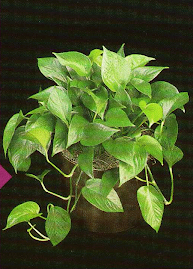Golden Pothos-------->
Scientific Classifications:::::
Epipremnum aureum~ otherwise known as Golden Pothos
Genus: Pothos
Thursday, February 26, 2009
Topic 9: Plant Science
9.3 Reproduction in Flowering Plants
1)
2)Pollination: The transfer of pollen grains from the anther to the stigma
Fertilization: Fusion of male and female gametes
Seed Dispersal: Mechanisms for distributing seeds away from the parent plant
3)
4)Conditions needed for the germination of a typical seed.
Imbibition
- Absorption of water, due to low water potential in dry seed, causes seed to swell, rupturing the seed coat and triggering metabolic changes in the embryo, causing it to resume growth.
-Giberellic Acid (GA) is released by embryo, which diffuses throughout seed, reaching the aleurone, the outer layer of the seed.
-Amylase, a digestive enzyme, is released by the aleurone when triggered by GA
-Endosperm starch is hydrolyzed into maltose by amylase
-Cotyledon absorbs maltose from endosperm into embryo
-Seedling grows from embryo fueled by the energy from maltose; stored lipids and proteins also hydrolyzed allowing for growth and development of the embryo.
6)Flowering is controlled in long-day and short-day plants, including the role of phytochrome:
9.3 Reproduction in Flowering Plants
1)
2)Pollination: The transfer of pollen grains from the anther to the stigma
Fertilization: Fusion of male and female gametes
Seed Dispersal: Mechanisms for distributing seeds away from the parent plant
3)
4)Conditions needed for the germination of a typical seed.
- Evolution of the seed: Key adaption of plants to terrestrial life
- Seed Dormancy increases the chance that germination will occur at the appropriate time
- Environmental cues:
- oxygen and water
- Desert
- Chaparral
- Temperate & Subarctic Zones
- Passage through animal Digestive Track
- Legnth of dormancy: varies from days to decades
Imbibition
- Absorption of water, due to low water potential in dry seed, causes seed to swell, rupturing the seed coat and triggering metabolic changes in the embryo, causing it to resume growth.
-Giberellic Acid (GA) is released by embryo, which diffuses throughout seed, reaching the aleurone, the outer layer of the seed.
-Amylase, a digestive enzyme, is released by the aleurone when triggered by GA
-Endosperm starch is hydrolyzed into maltose by amylase
-Cotyledon absorbs maltose from endosperm into embryo
-Seedling grows from embryo fueled by the energy from maltose; stored lipids and proteins also hydrolyzed allowing for growth and development of the embryo.
6)Flowering is controlled in long-day and short-day plants, including the role of phytochrome:
- Phytochrome is a pigment that exists in plants in two forms
- Pr, absorbs white/ red light
- Pfr, absorbs dark/ far-red light
- In white or red light Pr is converted to Pfr
- In far-red light or in darkness, Pfr gradually reverts to Pr
- Pfr acts as a promoter of flowering in long-day plants
- Pfr acts an inhibitor of flowering in short-day plants
Wednesday, February 25, 2009
Golden Pathos: An Overlook--------->
The plant that you see to your right is called the Golden Pathos as seen through a microscope, and at the bottom, as seen from your kitchen table. Some information on this plant:::
1)It is easy to grow
2)They are resistant to insect infestation and can withstand neglect (basically if you're a forgetful person or a plant abuser; it's okay, this plant does NOT need to be watered every day)
3)It originated in the Solomon Islands
4)Its long beautiful vines are good for purifying the very air that you breathe
1)It is easy to grow
2)They are resistant to insect infestation and can withstand neglect (basically if you're a forgetful person or a plant abuser; it's okay, this plant does NOT need to be watered every day)
3)It originated in the Solomon Islands
4)Its long beautiful vines are good for purifying the very air that you breathe
Topic 9: Plant Science
9.2 Transport and Angiospermophytes
1)Root systems provides a large surface area for mineral ion and water uptake by means of branching and root hairs by the following process: Cortex cells absorb ions that are dissolved in water, drawn in by capillary action through cortex cell walls. Branching increases quantity and area roots can absorb ions.
2)The ways in which mineral ions in the soil move to root:
Thickened cellulose, both xylem and phloem cells have thick secondary cell walls composed primarily of cellulose, providing rigidity
Cell turgor, plant cell vacuoles have low water potential; water enters the cell and vacuole by osmosis, causing the cell to swell against the cell wall which provides rigidity.
Lignified xylem, vascular tissue cells reinforced with helical or ring-shaped thickenings of the cellulose cell wall impregnated with lignin, which makes the cell walls hard, providing resistence to pressure.
5) Transpiration- loss of water vapor from the leaves and stems of plants
7) Guard cells can regulate transpiration by opening and closing stomata.
8)The plant hormone abscisic acid causes the closing of stomata.
10) Four adaptions that help to reduce transpiration are: The leaves having a thick cuticle and multiple–layered epidermal tissue that reduce water loss. The stomata are recessed in “crypts,” an adaptation that reduces the rate of transpiration by protecting the stomata from hot, dry wind. The trichomes (“hairs”) also help minimize transpiration by breaking up the flow of air, allowing the chamber of the crypt to have a higher humidity than the surrounding atmosphere. Thick, fleshy leaves to store water.
9.2 Transport and Angiospermophytes
1)Root systems provides a large surface area for mineral ion and water uptake by means of branching and root hairs by the following process: Cortex cells absorb ions that are dissolved in water, drawn in by capillary action through cortex cell walls. Branching increases quantity and area roots can absorb ions.
2)The ways in which mineral ions in the soil move to root:
- Diffusion of mineral ions down concentration gradients
- Mass flow of water in the soil carrying ions, when water drains through the soil
- Mineral ions move into fungal hyphae, which grow around plant roots in a mutualistic relationship, and then from the hyphae into the root.
Active transport: ATP oxidation provides the energy for protons to be pumped from the inside to the outside of root epidermal cell membranes= chemiosmosis, producing a H+ membrane potential
Cations, such as K+, are driven from the extracellular fluid into the intracellular fluid, through membrane channels, by their electrical charges repulsion from the H+'s concentrated in the extracellular fluid
Anions, such as NO3- move from the extracellular fluid into the intracellular fluid, through membrane channels, by co-transport with H+, which moves down its diffusion gradient.
4) Terrestrial plants support themselves by means of thickened cellulose, cell turgor, and lignified xylemCations, such as K+, are driven from the extracellular fluid into the intracellular fluid, through membrane channels, by their electrical charges repulsion from the H+'s concentrated in the extracellular fluid
Anions, such as NO3- move from the extracellular fluid into the intracellular fluid, through membrane channels, by co-transport with H+, which moves down its diffusion gradient.
Thickened cellulose, both xylem and phloem cells have thick secondary cell walls composed primarily of cellulose, providing rigidity
Cell turgor, plant cell vacuoles have low water potential; water enters the cell and vacuole by osmosis, causing the cell to swell against the cell wall which provides rigidity.
Lignified xylem, vascular tissue cells reinforced with helical or ring-shaped thickenings of the cellulose cell wall impregnated with lignin, which makes the cell walls hard, providing resistence to pressure.
5) Transpiration- loss of water vapor from the leaves and stems of plants
7) Guard cells can regulate transpiration by opening and closing stomata.
8)The plant hormone abscisic acid causes the closing of stomata.
10) Four adaptions that help to reduce transpiration are: The leaves having a thick cuticle and multiple–layered epidermal tissue that reduce water loss. The stomata are recessed in “crypts,” an adaptation that reduces the rate of transpiration by protecting the stomata from hot, dry wind. The trichomes (“hairs”) also help minimize transpiration by breaking up the flow of air, allowing the chamber of the crypt to have a higher humidity than the surrounding atmosphere. Thick, fleshy leaves to store water.
Topic 9: Plant Science
9.1 Plant Structure and Growth
1)


2)Three differences between the structures of dicotyledonous and monocotyledonous plants are:
4)Modifications:
6)In dicots, growth due to apical meristems: extends the length of the root or stem, uphold cell division in the apical meristematic region, uphold growth at the end of a root or stem. Growth due to lateral meristems: increase the girth of the stem, uphold cell division in the vascualr cambium, and upholds growth around the stem.
7)The role of auxin as an example of phototropism of the control of plant growth: Auxin is a plant hormone that stimulates cell elongation. One of the processes that auxin controls is phototropism which is the directional growth toward the source of light. shoot tips respond to light intensity by producing more auxin on the side with less light, making that side grow longer, thus bending the shoot tip toward the light.
9.1 Plant Structure and Growth
1)



2)Three differences between the structures of dicotyledonous and monocotyledonous plants are:
- The leaf venation of a monocot are parrallel while the vanation of a dicot are net-like.
- In the floral organs, the monocot petals are in multiples of three while the dicot pedals are in multiples of four and five.
- The roots of a monocot are fibrous adventitious while the dicots are tap roots with branching laterals.
4)Modifications:
- Roots: The purpose of storage roots, like sweet potato, are for the storage of starch and water.
- Stems:Bulbs, like onions, are the vertical underground shoots consisting of enlarged leaves with the purpose of storing food.
- Leaves: Tendrils, as on pea plants, serve the purpose of helping the plants cling onto objects for support and growth.
6)In dicots, growth due to apical meristems: extends the length of the root or stem, uphold cell division in the apical meristematic region, uphold growth at the end of a root or stem. Growth due to lateral meristems: increase the girth of the stem, uphold cell division in the vascualr cambium, and upholds growth around the stem.
7)The role of auxin as an example of phototropism of the control of plant growth: Auxin is a plant hormone that stimulates cell elongation. One of the processes that auxin controls is phototropism which is the directional growth toward the source of light. shoot tips respond to light intensity by producing more auxin on the side with less light, making that side grow longer, thus bending the shoot tip toward the light.
Subscribe to:
Posts (Atom)



